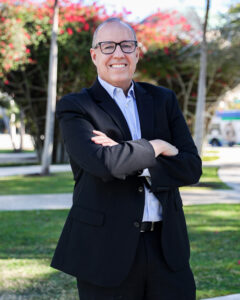Autonomous Florida Spotlight: Blink

 Brendan Jones is President and CEO at Blink Charging, a global leading vertically integrated manufacturer, owner, operator and provider of electric vehicle (EV) charging equipment and services. Blink manufactures NACS and CCS solutions for both Level 2 and Level 3 (DC Fast Charging) solutions. Learn more at blinkcharging.com
Brendan Jones is President and CEO at Blink Charging, a global leading vertically integrated manufacturer, owner, operator and provider of electric vehicle (EV) charging equipment and services. Blink manufactures NACS and CCS solutions for both Level 2 and Level 3 (DC Fast Charging) solutions. Learn more at blinkcharging.com
- What is one thing Floridians may not know about your industry?
Many are not aware of the importance of Level 2 (L2) chargers and how they differ from DC Fast Chargers. Blink manufactures both, but with so much attention given to DC Fast Chargers (which are certainly needed to address longer highway travel), many often overlook that 90% of all EV charging today is actually done using L2 chargers. L2s are more cost effective and easier to install than DC Fast Chargers. In fact, cars are parked most of the time (typically at home or at an office or at the site of an activity), and not actively driving on the road, so EVs can easily be charged by L2s as they sit … and can be ready to go when the driver actually needs to drive. L2s are perfectly designed for the average commuter and can easily be deployed in locations we utilize every day including retail, commercial, workplaces and in our homes. It’s important that EV drivers, and those drivers thinking about going electric, understand their charging needs will be and how effective L2 charging can be for everyday charging.
- What is one opportunity and one challenge your industry is facing?
There is a huge opportunity facing EV charging manufacturers such as Blink Charging as EV adoption continues to climb exponentially. Based on the current demands and mandates for electric vehicles, by 2030 we are going to need about 35 million chargers in North America alone to handle the amount of new EVs being sold. Blink is looking forward to providing many of those chargers. The industry challenges is identifying where to put all these new chargers. Blink is focused on strategically placing the right chargers in the right places, taking into consideration DC fast versus Level 2 chargers and maximizing on where cars typically dwell for long periods of time, such as at home and at work. In our home state of Florida that means partnering with the right organizations where locals live, work and play while also providing corridor, or highway, DC fast charging as tourists and locals traverse the state.
- What is one way we can unite to help grow your industry in Florida?
As as industry, we will thrive if businesses continue to work together, while engaging with local government agencies. In a collaborative manner, the industry can make smart decisions that support transportation routes, EV driving habits, and overall grid resiliency. Blink, headquartered in Florida, is well positioned locally and nationally to partner in that decision-making as a pioneer in the industry. Our team is always available to lend our experience and know-how on delivering EV charging solutions. We’re excited by the promise of the future and all the convenience and benefits Floridians will enjoy as the EV evolution continues to unfold.
About Blink Charging
Blink Charging Co. (Nasdaq: BLNK), a global leader in electric vehicle (EV) charging equipment, has contracted, sold, or deployed nearly 73,000 charging ports worldwide, many of which are networked EV charging stations, enabling EV drivers to easily charge at any of Blink’s charging locations. Blink’s principal line of products and services includes the Blink EV charging network (“Blink Network”), EV charging equipment, EV charging services, and the products and services of recent acquisitions, including SemaConnect, Blue Corner, BlueLA and Envoy. The Blink Network uses proprietary, cloud-based software that operates, maintains, and tracks the EV charging stations connected to the network and the associated charging data. With global EV purchases forecasted to half of passenger cars sold in the US by 2030, Blink has established key strategic partnerships for rolling out adoption across numerous location types, including parking facilities, multifamily residences and condos, workplace locations, health care/medical facilities, schools and universities, airports, auto dealers, hotels, mixed-use municipal locations, parks and recreation areas, religious institutions, restaurants, retailers, stadiums, supermarkets, and transportation hubs.
For more information, please visit https://www.blinkcharging.com/.